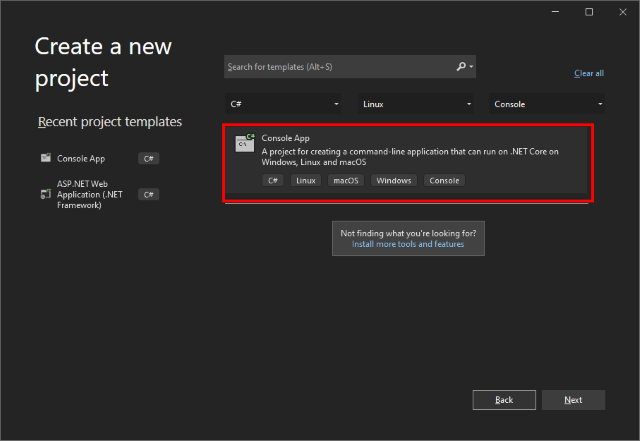This article explained the steps to build .NET Core in C# for running on CentOS/Linux/Ubuntu to backup & restore of MySQL database.
Introduction
MySqlBackup.NET is an open source project written in C# to perform backup & restore of MySQL database. This article will focus on how this library can be built to run on CentOS (Linux/Ubuntu).
Using the Code
The idea is to build a project in .NET Core and publish it as Linux package.
MySqlBackup.NET is an open source .NET Library (C#/VB.NET) to backup & restore MySQL database.
Here, we’re looking into how MySqlBackup.NET can be run on CentOS/Linux to perform backup & restore of MySQL database.
We can test this out with a simple Console App.

Start by creating a .NET Core Console Linux project:

Check the project properties, ensure the project is built with .NET Core Framework:

Install Nuget Package of MySqlBackup.NET (with MySqlConnector):


A simple sample code to test out:
static void Main(string[] args)
{
try
{
Console.WriteLine("Enter the MySQL Connection String: ");
Console.WriteLine();
string constr = Console.ReadLine();
Console.WriteLine();
Console.WriteLine();
Console.WriteLine(("Begin MySQL backup process..."));
string folder = Environment.CurrentDirectory;
string file = Path.Combine(folder, "backup.sql");
using (MySqlConnection conn = new MySqlConnection(constr))
{
using (MySqlCommand cmd = new MySqlCommand())
{
using (MySqlBackup mb = new MySqlBackup(cmd))
{
conn.Open();
cmd.Connection = conn;
mb.ExportToFile(file);
conn.Close();
}
}
}
Console.WriteLine("MySQL backup file saved at: " + file);
}
catch (Exception ex)
{
Console.WriteLine();
Console.WriteLine("Error: " + ex.Message);
}
Console.WriteLine();
Console.WriteLine("Press any key to exit...");
Console.ReadKey();
}
Next, publish the project for .NET Core (Linux):
There are two ways to build the .NET Core projects for Linux:
- Method 1: Publish the package with runtime support installed on CentOS
- Method 2: Publish as “self-contained” binary
Method 1: Publish the Package with Runtime Support Installed on CentOS
First, publish the project.

Set the target runtime to linux-x64:

In above example, the Linux compiled binaries are located at:
\bin\Release\netcoreapp3.1\publish\linux-x64
Copy the DLL in the above folder and paste it to your CentOS:
At the CentOS, make sure that you have installed Dotnet runtime by the following command:
sudo dnf install dotnet-sdk-<version>
For example:
sudo dnf install dotnet-sdk-3.1
sudo dnf install dotnet-sdk-5.0
Assume that you have copied your .NET Core DLL files at the following folder:
/home/<username>/testapp
Then you can test out your app with the following command:
cd /home/admin/testapp
dotnet ConsoleApp.dll
Method 2: Publish as “self-contained” Binary
.NET Core App can also be run without installing dotnet runtime, which is by compiling the project into a single “self-contained” binary.
Here is the screenshot for publishing the “self-contained” binary:

Here is the example of how it looks like after publishing, there is only 1 single file:

Copy the compiled binary to CentOS.
At the terminal, browse to the folder that contains the self-contained binary, for example:
cd /home/admin/testapp
Next, is to allow execution permission to the file:
sudo chmod 777 ConsoleApp2
Run the app:
./ConsoleApp2
For more information on publishing “self-contained” binary, read more here.
History
- 3rd February, 2022: Initial version
